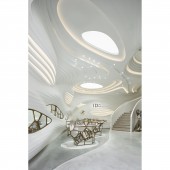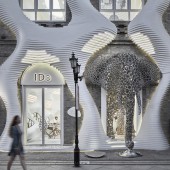I Do Emergent Arts Retail Space by AntiStatics Architecture |
Home > Winners > #137603 |
 |
|
||||
| DESIGN DETAILS | |||||
| DESIGN NAME: I Do Emergent Arts PRIMARY FUNCTION: Retail Space INSPIRATION: Responding to the program of the jewelry retail space, this project draws upon many of the symbolically referential elements related to the extraction, manufacture and distribution of rare stones. The attenuation of the walls, the sculpture and the geometric systems employed throughout the design serve to subtly draw attention to the larger ecosystem of this global economy. While we choose not to publicly or explicitly express our position as individuals, our intent is to promote awareness around the larger network inherent to the retail industry by presenting elements related to the production of goods. Beyond the physical artifacts within the space, the precise manifestation of these features are informed by processes incorporated in the production of goods. Lost-wax casting, carving and faceting are all presented as prominent design elements, while the translation of scale and utility suggest redefined meaning. UNIQUE PROPERTIES / PROJECT DESCRIPTION: The I Do artist store in Wuhan, China blends uniquely spatial and sculptural elements to create a highly expressive, enticing and inspiring user experience. At the center of the space, and protruding through the façade, a massive 9m steel sculpture rises from the first floor space and emerges on the second floor. Symbolically, the one to one scale elephant and figures represent the wisdom, strength and unity as a projection of the relationships which can be embodied by those visitors to the retail space. The sculpture is experienced through a variety of spatial relationships, as an iconic beacon within the larger outdoor public space, as a grandiose figure in the entry way, and intimately face to face with the figures on the second floor. Custom fabricated displays and furniture are faceted features which stand in contrast to the curvilinear strip form of the walls and ceilings. Expressive of the discovery and extraction process, the geometric contrast in these elements creates a dialogue beyond the limitations of retail spaces. Presented as dichotomous elements yet metaphorically interdependent, the arrangement of these components of the space elevate the experience from retail to immersive artwork. OPERATION / FLOW / INTERACTION: Beyond the conceptual determinants of the design this project challenges the potential of architecture as a communicative language utilizing iconography, referential geometries and fabrication processes to express ideas through space. The work pushes the boundaries of digital to physical fabrication methods and scales resulting in a new means of experiencing retail space. Developing new workflows for fabrication, the project creates novel environments better capable of expression. PROJECT DURATION AND LOCATION: The project began in 2018, designed in Beijing, Fabricated in Wuhan and Shanghai and installed in Wuhan in 2021. FITS BEST INTO CATEGORY: Interior Space and Exhibition Design |
PRODUCTION / REALIZATION TECHNOLOGY: Utilizing customized in-house computational tools in tandem with wax 3d printing and investment casting, the fabrication of the sculpture creates a sparse yet highly structural lattice inspired by both cellular biology and the atomic structure of diamonds. Expressing processes of terraforming, the walls and façade were produced through CNC milling and casting of Gypsum and GRC. Faceted displays and furniture are manufactured through digital models, automated production and manual fabrication. SPECIFICATIONS / TECHNICAL PROPERTIES: Retail Interiors: 16.4 x 14.7 m footprint, Ceiling Heights 5.7m, 4.9m Sculptural Installation 4.2m x 2.7m x 9m Façade 14m x 15.4m Laser Cut Artist Feature 2.5m x 4.4m TAGS: Digital Fabrication, Artificial Intelligence, Immersive, Conceptual, Future, RESEARCH ABSTRACT: This project involved a rigorous and intensive process of research into emerging capabilities of digital fabrication. Our goal was to find a new methodology for the production of highly-precise and structurally and materially efficient bio-inspired geometries using recyclable and proven materials such as stainless steel. Working closely with several fabricators and 3d printing innovators, we developed a process for the production of large-scale, bio-inspired cellular lattices. The design of the large sculptural piece for the store as a proof of concept for the future potential of architectural structural elements. The development algorithmically generated geometries for the execution of such a complex structure at this scale, presents a new paradigm for the use of structural materials like steel at an architectural scale. The algorithms written and developed by our design team use physics simulation engines to aid in the determination of bio-inspired geometries. These tools create a self-adapting localized densities of the lattice within the structure as determined by the global loading conditions of the form. This ensured that the 9 ton sculpture would be structurally sound, while also presenting a concept for the design of architectural structures which can use less material while creating more strength. The precise means of fabrication involves the determination of a valence 4 network of members which defines the shell of the form as well as the interior lattice. Building upon recent developments into macro-cellular solids, this project presents a system which is cleanly adaptable to solids in which loading conditions may vary within the volume, and increases or decreases density based need, further saving material. Reinventing the conventional process of lost wax casting for steel, the elements are 3d printing in wax and cast with stainless steel. This process was developed and utilized after less successful experiments using wire arc additive manufacturing proved overly limiting in terms of precision and execution of desired geometries. This work took on difficult scientific and engineering challenges as a means of opening new potentials for the conceptual and architectural presentation of space and form as metaphor. CHALLENGE: This project overcomes previous limitations in the fabrication of complex steel forms. Using a streamlined work flow from artificial intelligence to 3d printing to assembly, we redefined what was possible for highly precise, structurally responsive design. Working closely with several different fabricators throughout the design phase we were able to collaboratively develop novel method of streamlined workflow between AI and fabrication. ADDED DATE: 2022-02-27 14:33:14 TEAM MEMBERS (5) : Lead Architects: Mo Zheng + Martin Miller, Artist Collaborator: Yue Minjun, Design Team: Yasser Hafizs, Theodorius ED Santoso, Christopher Beckett, Annie Liu, Demi Chang, Arthur Yang, Frank Feng, Fabricator: Yueben Shanghai and IMAGE CREDITS: Copyrights belong to AntiStatics Architecture and I Do (Hiersun Group) Photography belong to AntiStatics Architecture and Dachou Wang Video Credits: Mo Zheng, AntiStatics, 2021 PATENTS/COPYRIGHTS: Copyrights belong to AntiStatics Architecture and I Do (Hiersun Group) |
||||
| Visit the following page to learn more: https://www.antistatics.net/i-do-artist- |
|||||
| AWARD DETAILS | |
 |
I Do Emergent Arts Retail Space by Antistatics Architecture is Winner in Interior Space and Exhibition Design Category, 2021 - 2022.· Read the interview with designer AntiStatics Architecture for design I Do Emergent Arts here.· Press Members: Login or Register to request an exclusive interview with AntiStatics Architecture. · Click here to register inorder to view the profile and other works by AntiStatics Architecture. |
| SOCIAL |
| + Add to Likes / Favorites | Send to My Email | Comment | Testimonials | View Press-Release | Press Kit | Translations |
Did you like Antistatics Architecture's Interior Design?
You will most likely enjoy other award winning interior design as well.
Click here to view more Award Winning Interior Design.








